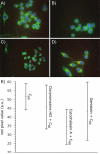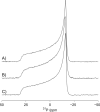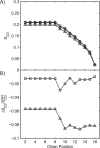C60 fullerene localization and membrane interactions in RAW 264.7 immortalized mouse macrophages
- PMID: 26866469
- PMCID: PMC4761875
- DOI: 10.1039/c5nr07003a
C60 fullerene localization and membrane interactions in RAW 264.7 immortalized mouse macrophages
Abstract
There continues to be a significant increase in the number and complexity of hydrophobic nanomaterials that are engineered for a variety of commercial purposes making human exposure a significant health concern. This study uses a combination of biophysical, biochemical and computational methods to probe potential mechanisms for uptake of C60 nanoparticles into various compartments of living immune cells. Cultures of RAW 264.7 immortalized murine macrophage were used as a canonical model of immune-competent cells that are likely to provide the first line of defense following inhalation. Modes of entry studied were endocytosis/pinocytosis and passive permeation of cellular membranes. The evidence suggests marginal uptake of C60 clusters is achieved through endocytosis/pinocytosis, and that passive diffusion into membranes provides a significant source of biologically-available nanomaterial. Computational modeling of both a single molecule and a small cluster of fullerenes predicts that low concentrations of fullerenes enter the membrane individually and produce limited perturbation; however, at higher concentrations the clusters in the membrane causes deformation of the membrane. These findings are bolstered by nuclear magnetic resonance (NMR) of model membranes that reveal deformation of the cell membrane upon exposure to high concentrations of fullerenes. The atomistic and NMR models fail to explain escape of the particle out of biological membranes, but are limited to idealized systems that do not completely recapitulate the complexity of cell membranes. The surprising contribution of passive modes of cellular entry provides new avenues for toxicological research that go beyond the pharmacological inhibition of bulk transport systems such as pinocytosis.
Figures










Similar articles
-
Passive transport of C60 fullerenes through a lipid membrane: a molecular dynamics simulation study.J Phys Chem B. 2008 Feb 21;112(7):2078-84. doi: 10.1021/jp075149c. Epub 2008 Jan 30. J Phys Chem B. 2008. PMID: 18229908
-
Interaction of fullerene nanoparticles with biomembranes: from the partition in lipid membranes to effects on mitochondrial bioenergetics.Toxicol Sci. 2014 Mar;138(1):117-29. doi: 10.1093/toxsci/kft327. Epub 2013 Dec 21. Toxicol Sci. 2014. PMID: 24361870
-
Uptake and translocation mechanisms of cationic amino derivatives functionalized on pristine C60 by lipid membranes: a molecular dynamics simulation study.ACS Nano. 2011 Nov 22;5(11):8571-8. doi: 10.1021/nn201952c. Epub 2011 Oct 13. ACS Nano. 2011. PMID: 21981729
-
Studying single-wall carbon nanotubes through encapsulation: from optical methods till magnetic resonance.J Nanosci Nanotechnol. 2007 Apr-May;7(4-5):1197-220. doi: 10.1166/jnn.2007.306. J Nanosci Nanotechnol. 2007. PMID: 17450887 Review.
-
Structure and dynamics in self-organized C60 fullerenes.J Nanosci Nanotechnol. 2007 Apr-May;7(4-5):1111-50. doi: 10.1166/jnn.2007.303. J Nanosci Nanotechnol. 2007. PMID: 17450883 Review.
Cited by
-
Nanomaterials in Medicine: Understanding Cellular Uptake, Localization, and Retention for Enhanced Disease Diagnosis and Therapy.Aging Dis. 2024 Feb 22;16(1):168-208. doi: 10.14336/AD.2024.0206-1. Online ahead of print. Aging Dis. 2024. PMID: 38421835 Free PMC article. Review.
-
Analysis of Biomechanical Parameters of Muscle Soleus Contraction and Blood Biochemical Parameters in Rat with Chronic Glyphosate Intoxication and Therapeutic Use of C60 Fullerene.Int J Mol Sci. 2021 May 7;22(9):4977. doi: 10.3390/ijms22094977. Int J Mol Sci. 2021. PMID: 34067082 Free PMC article.
-
C60 Fullerene as an Effective Nanoplatform of Alkaloid Berberine Delivery into Leukemic Cells.Pharmaceutics. 2019 Nov 8;11(11):586. doi: 10.3390/pharmaceutics11110586. Pharmaceutics. 2019. PMID: 31717305 Free PMC article.
-
Complexation with C60 Fullerene Increases Doxorubicin Efficiency against Leukemic Cells In Vitro.Nanoscale Res Lett. 2019 Feb 20;14(1):61. doi: 10.1186/s11671-019-2894-1. Nanoscale Res Lett. 2019. PMID: 30788638 Free PMC article.
-
State-of-the-Art of Polymer/Fullerene C60 Nanocomposite Membranes for Water Treatment: Conceptions, Structural Diversity and Topographies.Membranes (Basel). 2022 Dec 25;13(1):27. doi: 10.3390/membranes13010027. Membranes (Basel). 2022. PMID: 36676834 Free PMC article. Review.
References
-
- Aschberger K, Johnston HJ, Stone V, Aitken RJ, Tran CL, Hankin SM, Peters SAK, Christensen FM. Regul. Toxicol. Pharmacol. 2010;58:455–473. - PubMed
-
- Nielsen GD, Roursgaard M, Jensen KA, Poulsen SS, Larsen ST. Basic Clin. Pharmacol. Toxicol. 2008;103:197–208. - PubMed
-
- Johnston HJ, Hutchison GR, Christensen FM, Aschberger K, Stone V. Toxicol. Sci. 2010;114:162–182. - PubMed
-
- Zakharian TY, Seryshev A, Sitharaman B, Gilbert BE, Knight V, Wilson LJ. J. Am. Chem. Soc. 2005;127:12508–12509. - PubMed
-
- Montellano A, Ros TD, Bianco A, Prato M. Nanoscale. 2011;3:4035–4041. - PubMed
Publication types
MeSH terms
Substances
Grants and funding
LinkOut - more resources
Full Text Sources
Other Literature Sources

